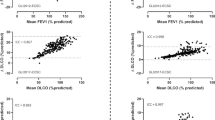Summary
Interpretation of lung function values in children with cystic fibrosis (CF) depends on the applied reference values. We hypothesize that differences between the new global lung function initiative (GLI) values and the formerly used Zapletal et al. values produce significantly different clinical results. We analyzed 3719 lung function measurements of 108 children and adolescents (n = 54 male; aged 6–18 years) with CF treated between September 1991 and July 2009. Data were analyzed in milliliters (ml) and % predicted (pred.) and interpreted using Zapletal and GLI reference values. Applying GLI compared to Zapletal resulted in significantly lower mean forced expiratory volume in 1s (FEV1)% pred. values: Zapletal 86.6% (SD 20.6), GLI 79.9% (SD 20.3) and 32% (n = 497/1543) were misclassified as normal when using Zapletal. Despite showing no overall differences in FEV1 and forced vital capacity (FVC) between concomitant Pseudomonas detection (PA+) in n = 938 and Pseudomonas negative (PA-) (n = 2781) using either reference PA+ resulted in lower FEV1 and FVC values with increasing age; however, measurement of small airway obstruction with forced expiratory flow at 75% of FVC (FEF75) values – available for Zapletal –showed significant differences. Reassurance regarding lung function when using old reference values may occur with potential clinical significance. Discrepancies in lung function interpretation underline the importance of using uniform and best available reference values.





Similar content being viewed by others
References
Gibson RL, Burns JL, Ramsey BW. Pathophysiology and management of pulmonary infections in cystic fibrosis. Am J Respir Crit Care Med. 2003;168(8):918–51.
Corey M, Edwards L, Levison H, Knowles M. Longitudinal analysis of pulmonary function decline in patients with cystic fibrosis. J Pediatr. 1997;131(6):809–14.
Farrell PM, Li Z, Kosorok MR, Laxova A, Green CG, Collins J, Lai HC, Makholm LM, Rock MJ, Splaingard ML. Longitudinal evaluation of bronchopulmonary disease in children with cystic fibrosis. Pediatr Pulmonol. 2003;36(3):230–40.
Davies JC, Alton EW. Monitoring respiratory disease severity in cystic fibrosis. Respir Care. 2009;54(5):606–17.
Enright PL, Beck KC, Sherrill DL. Repeatability of spirometry in 18,000 adult patients. Am J Respir Crit Care Med. 2004;169(2):235–8.
Gustafsson PM, Aurora P, Lindblad A. Evaluation of ventilation maldistribution as an early indicator of lung disease in children with cystic fibrosis. Eur Respir J. 2003;22(6):972–9.
Quanjer PH, Stanojevic S, Cole TJ, Baur X, Hall GL, Culver BH, Enright PL, Hankinson JL, Ip MS, Zheng J, et al. Multi-ethnic reference values for spirometry for the 3–95-yr age range: the global lung function 2012 equations. Eur Respir J. 2012;40(6):1324–43.
Stanojevic S, Stocks J, Bountziouka V, Aurora P, Kirkby J, Bourke S, Carr SB, Gunn E, Prasad A, Rosenfeld M, et al. The impact of switching to the new global lung function initiative equations on spirometry results in the UK CF registry. J Cyst Fibros. 2014;13(3):319–27.
Taylor-Robinson D, Whitehead M, Diderichsen F, Vebert Olesen H, Pressler T, Smyth R, Diggle P. Author’s response: understanding the natural progression in %FEV1 decline in patients with cystic fibrosis: a longitudinal study. Thorax. 2013;68(3):294–5.
Corey M. Power considerations for studies of lung function in cystic fibrosis. Proc Am Thorac Soc. 2007;4(4):334–7.
Welsh L, Robertson CF, Ranganathan SC. Increased rate of lung function decline in Australian adolescents with cystic fibrosis. Pediatr Pulmonol. 2014;49(9):873–7.
Stanojevic S, Bilton D, McDonald A, Stocks J, Aurora P, Prasad A, Cole TJ, Davies G. Global Lung Function Initiative equations improve interpretation of FEV1 decline among patients with cystic fibrosis. Eur Respir J. 2015;46(1):262–4.
Kirkby J, Aurora P, Spencer H, Rees S, Sonnappa S, Stocks J. Stitching and switching: the impact of discontinuous lung function reference equations. Eur Respir J. 2012;39(5):1256–7.
Zapletal A, Paul T, Samánek M. Significance of contemporary methods of lung function testing for the detection of airway obstruction in children and adolescents (author’s transl). Z Erkr Atmungsorgane. 1977;149(3):343–71.
American Thoracic Society. Lung function testing: selection of reference values and interpretative strategies. Am Rev Respir Dis. 1991;144(5):1202–18.
Quanjer PH, Weiner DJ. Interpretative consequences of adopting the Global Lungs 2012 reference equations for spirometry for children and adolescents. Pediatr Pulmonol. 2014;49(2):118–25.
Rosenbluth DB, Wilson K, Ferkol T, Schuster DP. Lung function decline in cystic fibrosis patients and timing for lung transplantation referral. Chest. 2004;126(2):412–9.
Demko CA, Byard PJ, Davis PB. Gender differences in cystic fibrosis: pseudomonas aeruginosa infection. J Clin Epidemiol. 1995;48(8):1041–9.
Dasenbrook EC, Merlo CA, Diener-West M, Lechtzin N, Boyle MP. Persistent methicillin-resistant Staphylococcus aureus and rate of FEV1 decline in cystic fibrosis. Am J Respir Crit Care Med. 2008;178(8):814–21.
Bakker EM, Borsboom GJ, van der Wiel-Kooij EC, Caudri D, Rosenfeld M, Tiddens HA. Small airway involvement in cystic fibrosis lung disease: routine spirometry as an early and sensitive marker. Pediatr Pulmonol. 2013;48(11):1081–8.
Lukic KZ, Coates AL. Does the FEF25-75 or the FEF75 have any value in assessing lung disease in children with cystic fibrosis or asthma? Pediatr Pulmonol. 2015;50(9):863–8.
Merkus PJ, Tiddens HA, de Jongste JC. Annual lung function changes in young patients with chronic lung disease. Eur Respir J. 2002;19(5):886–91.
Acknowledgements
The authors would like to thank the “CF HILFE Wien Niederösterreich und Burgenland” for their support of the study.
Author information
Authors and Affiliations
Corresponding author
Ethics declarations
Conflict of interest
A. Zacharasiewicz, S. Renner, F. Haderer, M. Weber, E. Dehlink, Zsolt Szepfalusi, and T. Frischer declare that they have no competing interests.
Ethical standards
The ethics committee of the department of pediatrics of the Medical University of Vienna approved the collection and analysis of lung function data of all CF patients of the center in retrospect; hence, all CF lung function data were available and included into the study.
Rights and permissions
About this article
Cite this article
Zacharasiewicz, A., Renner, S., Haderer, F. et al. Early detection of lung function decrements in children and adolescents with cystic fibrosis using new reference values. Wien Klin Wochenschr 129, 533–539 (2017). https://doi.org/10.1007/s00508-017-1184-0
Received:
Accepted:
Published:
Issue Date:
DOI: https://doi.org/10.1007/s00508-017-1184-0




